Effects of Planting Density on Root Spatial and Temporal Distribution and Yield of Winter Wheat
Abstract
1. Introduction
2. Materials and Methods
2.1. The Experimental Site
2.2. Materials and Methods
2.3. Statistical Analysis
3. Results
3.1. Temporal and Spatial Distribution Characteristics of Root Length Density
3.2. Spatiotemporal Distribution Characteristics of Root Diameter
3.3. Spatial and Temporal Distribution Characteristics of Root Dry Weight Density
4. Discussion
4.1. Effect of Plant Row Configuration on Temporal and Spatial Distribution of Winter Wheat Roots
4.2. Correlation Analysis of Root Index and Yield
4.3. Relationship between Root Spatial Distribution and Yield
5. Conclusions
Author Contributions
Funding
Data Availability Statement
Conflicts of Interest
References
- Zhou, J.G.; Zhai, Y.L.; Chen, G.D.; Xin, Y.; Zhang, L.; Wu, Q.Z. Spatiotemporal Distribution Characteristics and Yield Impact of Uniform Winter Wheat Root Systems at Different Densities. Fresenius Environ. Bull. 2022, 31, 9540–9547. [Google Scholar]
- Graeme, L.; Zhan, D. Can Changes in Canopy and/or Root System Architecture Explain Historical Maize Yield Trends in the U.S. Corn Belt. Crop Sci. 2009, 49, 299–312. [Google Scholar]
- Sharma, B.R.; Chaudhary, T.N. Wheat root growth, grain yield and water uptake as influenced by soil water regime and depth of nitrogen placement in a loamy sand soil. Agric. Water Manag. 1983, 6, 365–373. [Google Scholar] [CrossRef]
- Godfray, H.C.J.; Beddington, J.R.; Crute, I.R.; Haddad, L.; Lawrence, D.; Muir, J.F.; Pretty, J.; Robinson, S.; Thomas, S.M.; Toulmin, C. Food security: The challenge of feeding 9 billion people. Science 2010, 327, 812–818. [Google Scholar] [CrossRef]
- World Bank. World Development Report 2008: Agriculture for Development; World Bank: Washington, DC, USA, 2008. [Google Scholar]
- Chaudhary, A.; Gustafson, D.; Mathys, A. Multi-indicator sustainability assessment of global food systems. Nat. Commun. 2018, 9, 848. [Google Scholar] [CrossRef]
- Kearney, J. Food Consumption Trends and Drivers. Philos. Trans. R. Soc. B Biol. Sci. 2010, 365, 2793–2807. [Google Scholar] [CrossRef]
- Mei, S.; Zhu, H.; Wang, S.; Yang, X. Research Situation and Prospects ofWheat Root System. Genom. Appl. Biol. 2018, 37, 5448–5454. [Google Scholar]
- Fang, Y.; Min, D.; Gao, X.; Wang, Z.; Wang, J.; Liu, P.; Liu, X. Relationship between spatiotemporal distribution of roots and grain yield of winter wheat varieties with differing drought tolerance. Acta Ecol. Sin. 2019, 39, 2922–2934. [Google Scholar]
- Cunhua, S.; Song, B.; Baozhang, B.; Yang, L.; Wei, X. Effect of Water Stress on Root Growth and Physiological Characters of Wheat Seedlings. J. Jilin Agric. Univ. 2003, 25, 485–489. [Google Scholar]
- Sun, Y.; Zhang, S.; Chen, W. Root traits of dryland winter wheat (Triticum aestivum L.) from the 1940s to the 2010s in Shaanxi Province, China. Sci Rep. 2020, 10, 5328. [Google Scholar] [CrossRef]
- Zhou, B.Z.; Zhang, S.G.; Fu, M.Y. Minirhizotron, a new technique for plant root system research: Its invention, development and application. Chin. J. Ecol. 2007, 26, 253–260. [Google Scholar]
- Zhao, B.; Niu, X.; Ata-Ul-Karim, S.T.; Wang, L.; Duan, A.; Liu, Z.; Lemaire, G. Determination of the post-anthesis nitrogen status using ear critical nitrogen dilution curve and its implications for nitrogen management in maize and wheat. Eur. J. Agron. 2020, 113, 125967. [Google Scholar] [CrossRef]
- Niu, X.; Zhou, H.; Wang, X.; Hu, T.; Feng, P.; Li, T.; Zhao, N.; Yin, D. Changes in root hydraulic conductance in relation to the overall growth response of maize seedlings to partial root-zone nitrogen application. Agric. Water Manag. 2020, 229, 105839. [Google Scholar]
- Sun, D.; Li, H.; Wang, E.; He, W.; Hao, W.; Yan, C.; Li, Y.; Mei, X.; Zhang, Y.; Sun, Z.; et al. An overview of the use of plastic film mulching in China to increase crop yield and water use efficiency. Natl. Sci. Rev. 2020, 7, 1523–1526. [Google Scholar] [CrossRef] [PubMed]
- Wang, Y.; Liu, H.; Huang, Y.; Wang, J.; Wang, Z.; Gu, F.; Xin, M.; Kang, G.; Feng, W.; Guo, T. Effects of cultivation management on the winter wheat grain yield and water utilization efficiency. Sci. Rep. 2019, 9, 12733. [Google Scholar] [CrossRef] [PubMed]
- Lyu, G.; Xie, Y.; Wen, R.; Wang, X.; Jia, Q. Modeling root biomass of maize in Northeast China. Chin. J. Eco-Agric. 2019, 27, 572–580. [Google Scholar]
- Postic, F.; Beauchêne, K.; Gouache, D.; Doussan, C. Scanner-Based Minirhizotrons Help to High-light Relations between Deep Roots and Yield in Various Wheat Cultivars under Combined Water and Nitrogen Deficit Conditions. Agronomy 2019, 9, 297. [Google Scholar] [CrossRef]
- Duan, G.; Tian, W.; Wen, H.; Zhang, Y.; Peng, S.; Zhang, S.; Lv, S.; Wang, H.; Gao, H. Differences in Root Growth and Yield Among Winter Wheat Varieties with Different Genotypes. Barley Cereal Sci. 2018, 35, 25–28. [Google Scholar]
- Sun, H.Y.; Shen, Y.J.; Yu, Q.; Gerald, N.F.; Zhang, Y.Q.; Liu, C.M.; Zhang, X. Effect of precipitation change on water balance and W.U.E. of the winter wheat-summer maize rotation in the North China Plain. Agr. Water Manag. 2010, 97, 1139–1145. [Google Scholar] [CrossRef]
- Abi Saab, M.T.; El Alam, R.; Jomaa, I.; Skaf, S.; Fahed, S.; Albrizio, R.; Todorovic, M. Coupling Remote Sensing Data and AquaCrop Model for Simulation of Winter Wheat Growth under Rainfed and Irrigated Conditions in a Mediterranean Environment. Agronomy 2021, 11, 2265. [Google Scholar] [CrossRef]
- Xin, Y.; Gao, L.; Hu, W.; Gao, Q.; Yang, B.; Zhou, J.; Xu, C. Genome-Wide Association Study Based on Plant Height and Drought-Tolerance Indices Reveals Two Candidate Drought-Tolerance Genes in Sweet Sorghum. Sustainability 2022, 14, 14339. [Google Scholar] [CrossRef]
- Eberbach, P.; Pala, M. Crop row spacing and its influence on the partitioning of evapotranspiration by winter-grown wheat in Northern Syria. Plant Soil 2005, 268, 195–208. [Google Scholar] [CrossRef]
- Zhai, Y.; Wu, Q.; Chen, G.; Zhang, H.; Yin, X.; Chen, F. Broadcasting winter wheat can increase grain yield without reducing the kernels per spike and the kernel weight. Sustainability 2018, 10, 4858. [Google Scholar] [CrossRef]
- Waines, J.G.; Ehdaie, B.E. Optimizing Root Characters and Grain Yield in Wheat. Czech J. Genet. Plant Breed. 2005, 41, 326–330. [Google Scholar] [CrossRef]
- Morita, S.; Okuda, H.; Abe, J. Root System Morphology of Wheat Grown under Different Soil Moisture and Transpiration Rates afer Rehydration. Agric. Meteorol. 2010, 52, 819–822. [Google Scholar] [CrossRef][Green Version]
- Chen, C.; Karnes, N.; Dave, W.; Malvern, W. Hard Red Spring Wheat Response to Row Spacing, Seeding Rate, and Nitrogen. Agron. J. 2008, 100, 1296–1302. [Google Scholar] [CrossRef]
- Gautam, P.; Xue, Q.; Jessup, K.E.; Rudd, J.C.; Liu, S.; Mahan, J.R. Cooler Canopy Contributes to Higher Yield and Drought Tolerance in New Wheat Cultivars. Crop Sci. 2014, 54, 2275–2284. [Google Scholar]
- Meng, Q.; Yue, S.; Chen, X.; Cui, Z.; Ye, Y.; Ma, W.; Tong, Y.; Zhang, F. Understanding dry matter and nitrogen accumulation with time-course for high-yielding wheat production in China. PLoS ONE 2013, 8, e68783. [Google Scholar] [CrossRef]
- Jessop, R.S.; Stewart, L.W. Effects of crop residues, soil type and temperature on emergence and early growth of wheat. Plant Soil 1983, 74, 101–109. [Google Scholar] [CrossRef]
- Olsen, J.M.; Griepentrog, H.W.; Nielsen, J.; Weiner, J. How Important are Crop Spatial Pattern and Density for Weed Suppression by Spring Wheat? Weed Sci. 2012, 60, 501–509. [Google Scholar] [CrossRef]
- Hossain, A.; Skalicky, M.; Brestic, M.; Maitra, S.; Ashraful Alam, M.; Syed, M.A.; Hossain, J.; Sarkar, S.; Saha, S.; Bhadra, P.; et al. Consequences and Mitigation Strategies of Abiotic Stresses in Wheat (Triticum aestivum L.) under the Changing Climate. Agronomy 2021, 11, 241. [Google Scholar] [CrossRef]
- Chen, T.; Zhu, Y.; Dong, R.; Ren, M.; He, J.; Li, F. Belt Uniform Sowing Pattern Boosts Yield of Different Winter Wheat Cultivars in Southwest China. Agriculture 2021, 11, 1077. [Google Scholar] [CrossRef]
- Ding, Y.; Tang, X.; Zhang, X.; Zhu, M.; Li, C.; Zhu, X.; Ding, J.; Guo, W. Effects of Weak- and Semi-Winter Cultivars of Wheat on Grain Yield and Agronomic Traits by Breaking through Traditional Area Planting. Agronomy 2022, 12, 196. [Google Scholar] [CrossRef]
- Tian, Z.W.; Jing, Q.; Dai, T.B.; Jiang, D.; Cao, W.X. Effects of genetic improvements on grain yield and agronomic traits of winter wheat in the Yangtze River Basin of China. Field Crop. Res. 2011, 124, 417–425. [Google Scholar] [CrossRef]
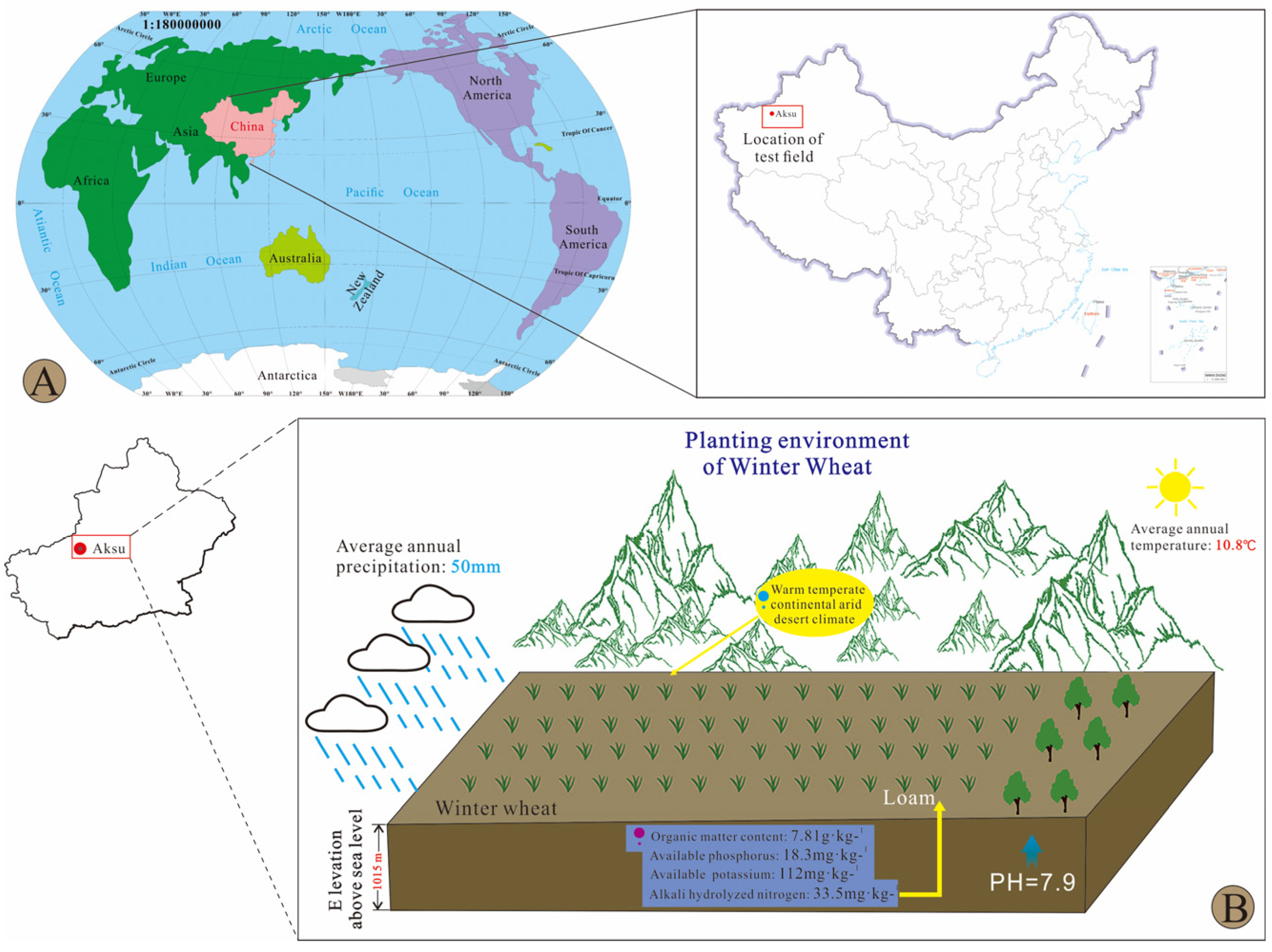
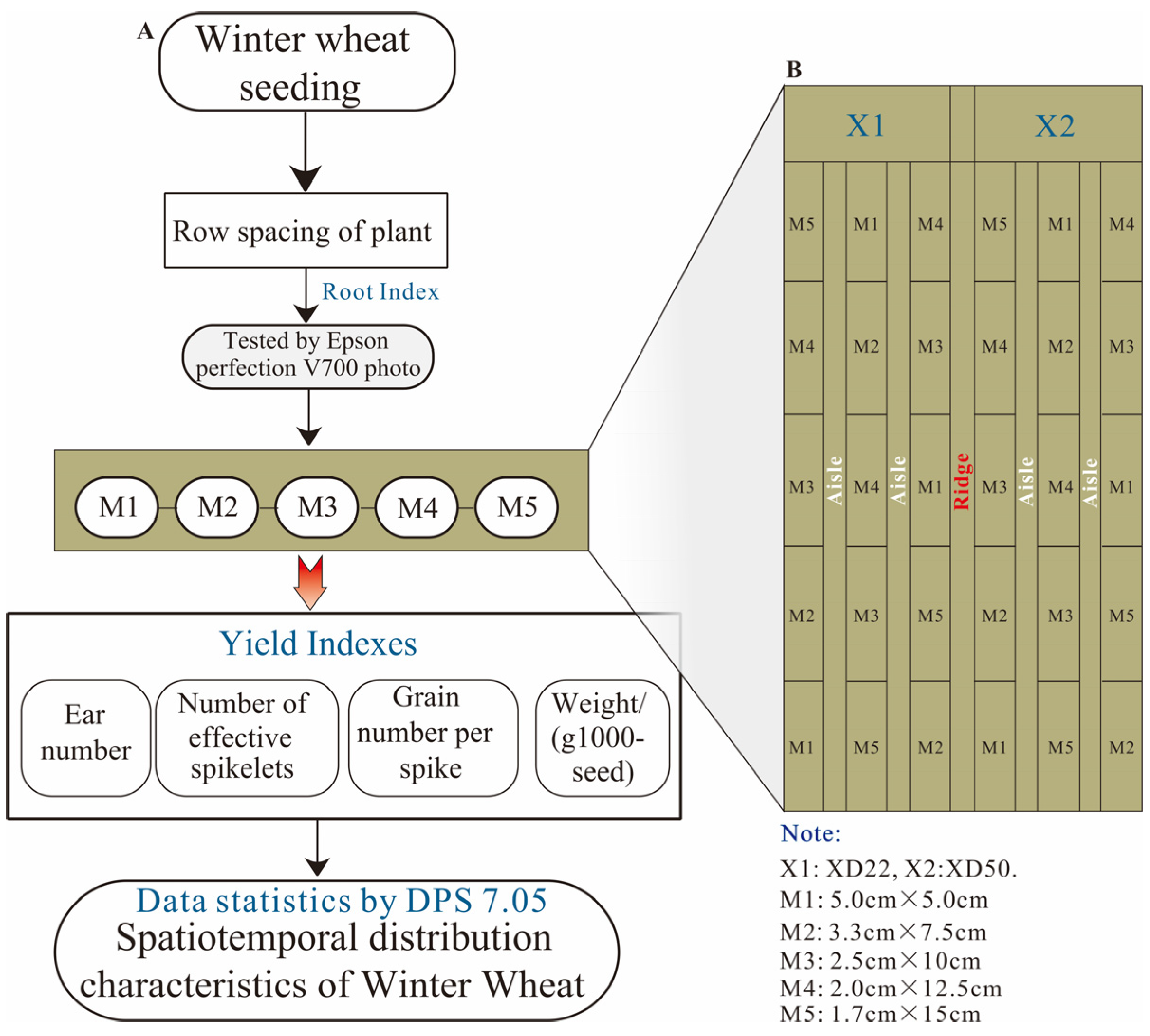
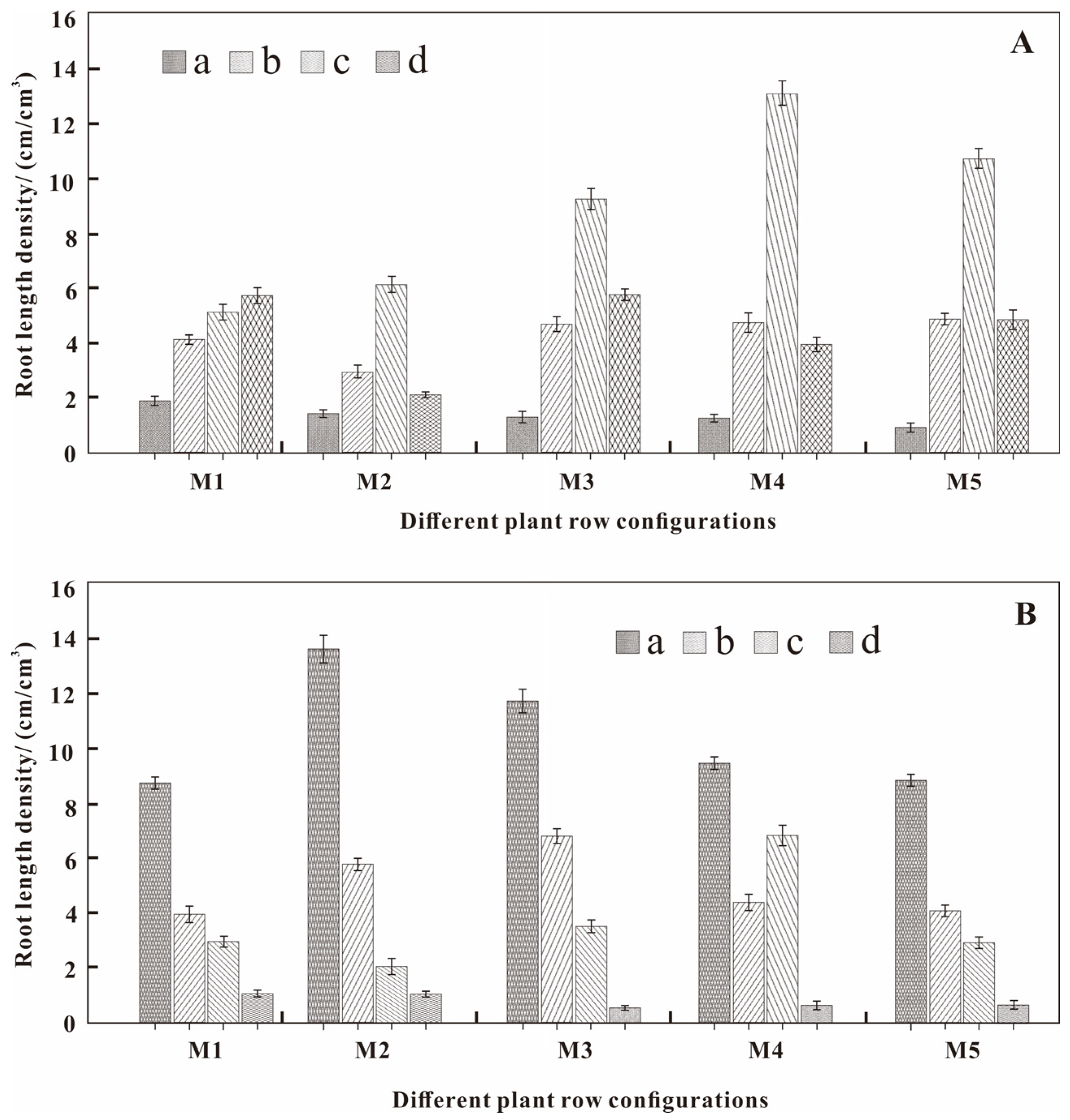

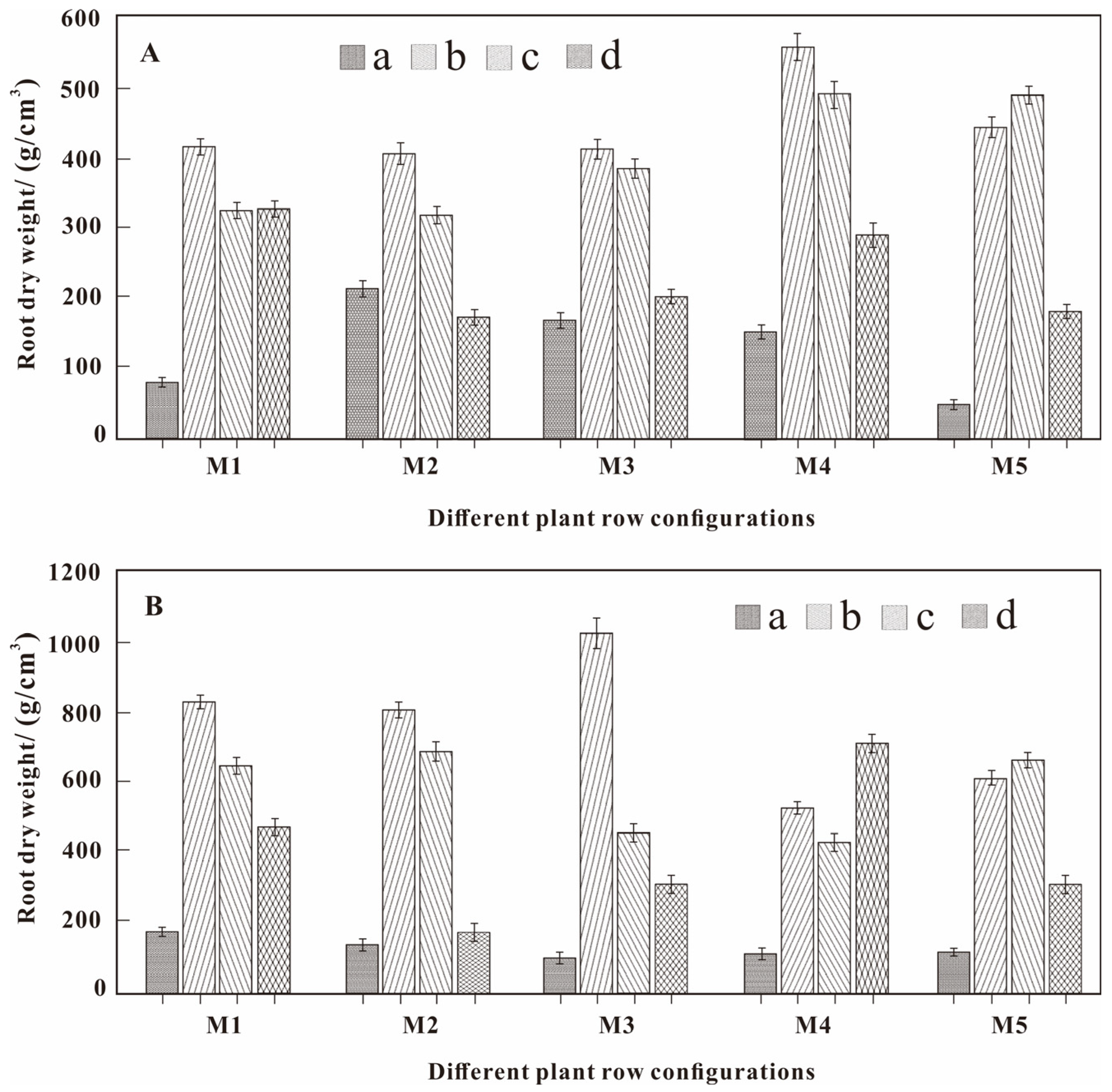
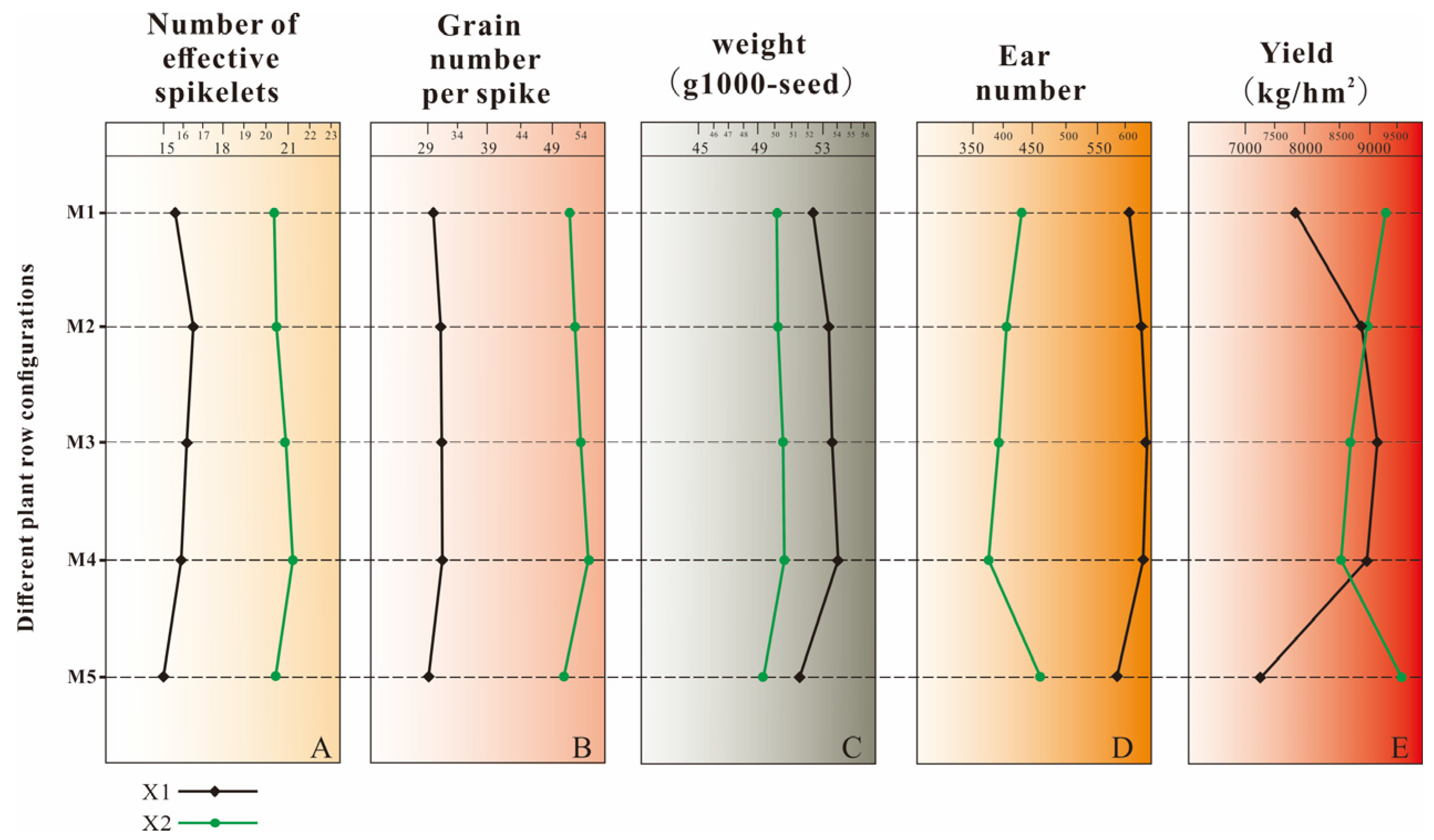
| Time | Treatment | Ear Number | Number of Effective Spikelets | Grain Number Per Spike | Weight/(g1000-Seed) | Yield/(kg/hm2) |
|---|---|---|---|---|---|---|
| 2 October 2019–18 June 2020 | X1M4 | 633.67 bA | 15.9 bAB | 32.05 aA | 54.07 aA | 8933.75 abAB |
| X1M3 | 642.67 aA | 16.15 abAB | 31.95 aA | 53.69 abA | 9180.65 aA | |
| X1M2 | 631.67 bA | 16.5 aA | 31.1 abAB | 53.42 bA | 8779.65 bB | |
| X1M1 | 608.00 cB | 15.65 bBC | 30 bcAB | 52.34 cB | 7881.65 cC | |
| X1M5 | 583.67 dC | 15 cC | 29.05 cB | 51.5 dC | 7295.15 dD | |
| X2M4 | 375.67 dD | 21.2 aA | 55.67 aA | 50.56 aA | 8527.25 dD | |
| X2M3 | 393.33 dCD | 20.97 abA | 54.03 bAB | 50.5 aA | 8710.15 dCD | |
| X2M2 | 412.67 cBC | 20.47 abA | 53.1 bcBC | 50.21 aA | 8985.6 cBC | |
| X2M1 | 433.67 bB | 20.37 bA | 52.13 cdBC | 50.19 aA | 9267.2 bAB | |
| X2M5 | 467 aA | 20.3 bA | 50.97 dC | 49.29 aA | 9599.65 aA |
| Correlation | X1 | X2 | X1 | X2 | X1 | X2 | X1 | X2 | X1 | X2 | |
|---|---|---|---|---|---|---|---|---|---|---|---|
| 0–20 cm | 20–40 cm | 40–60 cm | 60–80 cm | 80–100 cm | |||||||
| Root length density | Winter period | −0.335 | 0.466 | 0.502 | 0.4 | 0.931 ** | 0.021 | 0.901 ** | −0.238 | ||
| Jointing stage | −0.217 | −0.195 | 0.524 * | −0.222 | −0.026 | −0.694 ** | −0.226 | −0.695 ** | −0.634 * | −0.955 ** | |
| Heading stage | −0.064 | 0.268 | 0.487 | −0.13 | −0.202 | −0.056 | −0.48 | 0.903 ** | −0.624 * | 0.28 | |
| Mature stage | 0.258 | −0.582 * | −0.383 | −0.317 | −0.407 | −0.807 ** | 0.243 | −0.085 | −0.13 | −0.597 * | |
| Root diameter | Winter period | −0.179 | 0.302 | 0.222 | 0.139 | 0.857 ** | 0.146 | 0.888 ** | −0.286 | ||
| Jointing stage | −0.461 | −0.147 | 0.383 | −0.212 | −0.704 ** | −0.323 | 0.043 | −0.407 | 0.236 | −0.454 | |
| Heading stage | −0.229 | 0.016 | 0.413 | −0.678 ** | 0.048 | −0.248 | −0.638 * | 0.768 ** | −0.613 * | 0.714 ** | |
| Mature stage | 0.256 | −0.337 | −0.383 | 0.332 | 0.066 | −0.005 | 0.381 | −0.302 | 0.504 | −0.439 | |
| Root dry weight density | Winter period | 0.829 ** | 0.462 | 0.796 ** | −0.209 | 0.481 | 0.153 | 0.871 ** | −0.139 | ||
| Jointing stage | −0.022 | 0.037 | 0.699 ** | 0.042 | 0.054 | −0.143 | 0.028 | −0.892 ** | −0.324 | −0.858 ** | |
| Heading stage | −0.333 | 0.618 * | 0.616 * | 0.078 | −0.703 ** | 0.423 | −0.497 | 0.876 ** | −0.924 ** | 0.012 | |
| Mature stage | 0.032 | −0.266 | −0.327 | 0.163 | −0.540 * | −0.556 * | −0.098 | −0.527 * | 0.2 | −0.603 * | |
Publisher’s Note: MDPI stays neutral with regard to jurisdictional claims in published maps and institutional affiliations. |
© 2022 by the authors. Licensee MDPI, Basel, Switzerland. This article is an open access article distributed under the terms and conditions of the Creative Commons Attribution (CC BY) license (https://creativecommons.org/licenses/by/4.0/).
Share and Cite
Zhou, J.; Zhang, Z.; Xin, Y.; Chen, G.; Wu, Q.; Liang, X.; Zhai, Y. Effects of Planting Density on Root Spatial and Temporal Distribution and Yield of Winter Wheat. Agronomy 2022, 12, 3014. https://doi.org/10.3390/agronomy12123014
Zhou J, Zhang Z, Xin Y, Chen G, Wu Q, Liang X, Zhai Y. Effects of Planting Density on Root Spatial and Temporal Distribution and Yield of Winter Wheat. Agronomy. 2022; 12(12):3014. https://doi.org/10.3390/agronomy12123014
Chicago/Turabian StyleZhou, Jianguo, Zhiwen Zhang, Yue Xin, Guodong Chen, Quanzhong Wu, Xueqi Liang, and Yunlong Zhai. 2022. "Effects of Planting Density on Root Spatial and Temporal Distribution and Yield of Winter Wheat" Agronomy 12, no. 12: 3014. https://doi.org/10.3390/agronomy12123014
APA StyleZhou, J., Zhang, Z., Xin, Y., Chen, G., Wu, Q., Liang, X., & Zhai, Y. (2022). Effects of Planting Density on Root Spatial and Temporal Distribution and Yield of Winter Wheat. Agronomy, 12(12), 3014. https://doi.org/10.3390/agronomy12123014







